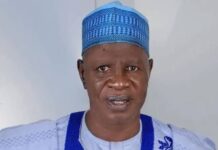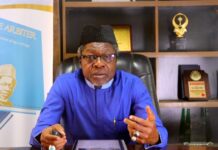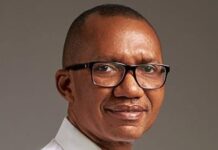BreakThrough
Nuclear technology is a technology that permits the exploitation of nuclear energy. This is an energy held in the nucleus of an atom. The energy is obtained through two types of reactions – fission and fusion; Nuclear reaction. Large volume of energy can be obtained from Nuclear reaction. For example, through fission, one million times more energy per atom than fossil fuel can be obtained from the same atom. No doubt discussion on this type of technology is a complex technical process beyond the scope of newspaper column. However, it is important to understand this technology and its potential for usefulness and destruction to mankind and environment. The technology was first developed in the 1940s during the Second World War.
Historically, it can be recalled that the development and use of atomic bomb, which is one form of the nuclear technology in 1945 ended the World War II. United States of America used the atomic bomb twice on towns of Hiroshima and Nagasaki, Japan, which caused colossal and instant destruction of lives and properties. USA developed two types of atomic bombs: “little boy”, a uranium-based bomb and “fat man”, which was a plutonium-based weapon. The World War II was almost ending as at April 1945 in Europe but fierce fighting continued in the Pacific between Japanese forces and USA forces. In late July, the then President of USA, Harry Truman called for Japan’s surrender with the “Potsdam Declaration”. The declaration warned of “prompt and utter destruction” to Japan, if it fails to surrender. On August 6, 1945, the first atomic bomb “little boy” was dropped on Japanese city of Hiroshima from a B-29 bomber plane called the “Enola Gay”.
The “Little Boy” exploded with about 13 kilotons of force, leveling eight square kilometers of the city thereby killing 80,000 people instantly. Tens of thousands more died later due to exposure of radiation. Three days after the calamitous destruction, still, there was no immediate surrender; the second atomic bomb “fat man” was dropped on the city on Nagasaki that similarly killed an estimated number of 40,000 people by the impact of the bomb. That made Japan to surrender and abrupt end of the Second World War.
The dreadful and mammoth impact of nuclear technology as weapon of mass destruction in the history of humanity has united the world against its use. However, acquisition of nuclear technology by countries became a symbol of military prowess and shows of muscle. Soon, several countries acquired nuclear weapons. Within first few decades after using atomic bombs, USA and USSR stockpiled tens of thousands of nuclear warheads that initiated the so-called “Cold War”. Few countries such as Great Britain, France, and China developed nuclear weapons during this cold war era. The world became a fearful planet to live; it was surrounded by uncertainty and anxiety. People were almost living by the day.
The concern in the Cold war era created an antinuclear movement in 1961. It was a social movement created out of necessity at the height of the Cold War. During the era, Women groups staged Peaceful demonstrations on November 1, 1961. An estimated number of 50,000 women marched in 60 cities in the United States demonstrated against nuclear weapons massively acquired by the developed countries. The antinuclear movement captured international attention again in the 1970s and 1980s with high profile protests against nuclear reactors after the Three Mile Island accident—a nuclear meltdown at a Pennsylvania power plant in 1979. The most fearful aspect of nuclear technology as weapon of mass destruction is ‘once detonated, the impact of the weapon has no respect of spatial boundary of a country nor has it temporal limitation on the living things’. Neighborhoods of the target are likely to be affected and similarly people in the affected area will continue to suffer radiation exposure from generation to generation.
The global protests by antinuclear demonstrators forced the world to initiate Nuclear Non-Proliferation Treaty (NPT). USA and USSR took the lead in negotiating an international agreement to halt the further spread of nuclear weapons in 1968.The Treaty on the Non-Proliferation of Nuclear Weapons (also called the Non-Proliferation Treaty or NPT) went into effect in 1970. It separated the world’s countries into two groups—nuclear weapons states and non-nuclear weapons states. Nuclear weapons states included the five countries that were known to possess nuclear weapons at the time—the United States, the U.S.S.R., Great Britain, France and China. These five countries agreed not to use nuclear weapons or help non-nuclear states acquire nuclear weapons. They also agreed to gradually reduce their stockpiles of nuclear weapons with the eventual goal of total disarmament. Non-nuclear weapons states agreed not to acquire or develop nuclear weapons. However, nuclear technology is not only for weaponry, it is also useful as source of energy for national development.
As early as in the 1950s, attention was turned to the peaceful use of nuclear technology, using it to generate power. In the last three decades, nuclear power plants have been operational in more than 30 countries worldwide. In fact, through regional transmission grids, many more countries depend in part on nuclear-generated power; example, Italy and Denmark receive power supplies of 10% of their electricity from imported nuclear power. Today, nuclear technology is used for studies in neutron physics, agricultural sciences, mineral exploration and similar other things. This civilian use of nuclear technology for national development is the context at which Ahmadu Bello University (ABU) Zaria is creating waves in the last two decades.
ABU Zaria through its Center for Energy Research and Training (CERT) has been training and producing competent nuclear scientists using the only nation’s Miniature Neutron Source Reactors (MNSR) located at the university. The recent conversion of highly enriched uranium (HEU) nuclear reactor to fuel containing low-enriched uranium (LEU) became the latest in this wave creation. The feat is certainly the pinnacle to ensure that the Nigerian only nuclear technology is used for peaceful nation building. It is a practical demonstration of Nigeria’s interest in joining the race for the peaceful, safe and secure uses of nuclear technology. The advent of international terrorist groups across the globe makes it imperative to distant nuclear technology from accessibility and use by these inhuman elements. The emergence of Boko Haram with their limited usage of improvised explosive devices (IEDs) in their terrorist acts underscores the importance of the university’s singular achievement. How was the conversion from highly enriched uranium to low enriched uranium achieved? Was the conversion necessary? Before then, it is important to provide brief on the roles of CERT in the development of nuclear physics in the country.
CERT was established as a Centre of Excellence in Nuclear Science and Technology in 1986 under statute 29 of the Ahmadu Bello University Laws. The nuclear reactor was installed at the Centre in 1997, making the country the 6th African nation with nuclear technology. The five other countries are South Africa, Ghana, Egypt, Morocco and Democratic Republic of Congo, to acquire a “classified nuclear facility”, licensed by the world’s nuclear development ombudsman, the International Atomic Energy Agency (IAEA). Thus, the Centre is the only country’s IAEA’s approved classified nuclear facility. It occupies a 32 hectare of land with five departments: Nuclear Science and Technology, Materials Science and Development, Engineering and Instrumentation Design, Health Physics and radio bi-physics and Reactor Engineering. The center started as a nuclear program of Ahmadu Bello University, Zaria as far back as in 1977. The program was transformed to a unit of the university in 1986. It was established basically to carry out basic and applied research in nuclear science and technology and also to train Nigerians on energy matters and nuclear science and technology. The nuclear facility presently has over 150 personnel comprising nuclear research staff, technical staff and supporting staff as recommended by IAEA international security safeguard. The center has trained and sent several Nigerians to various parts of the world over the years. It has also acquired several research equipment and facilities in nuclear science and technology. Some of these facilities include the only research reactor in the country and a neutron generator. It also has the only licensed radioactive waste management facility in the country and various analytical and radiation management facilities for various applications.
Professor Othman is the Executive Director of National Agricultural Extension and Research Liaison Services (NAERLS), ABU Zaria.
Follow the Neptune Prime channel on WhatsApp:
Do you have breaking news, interview request, opinion, suggestion, or want your event covered? Email us at neptuneprime2233@gmail.com




